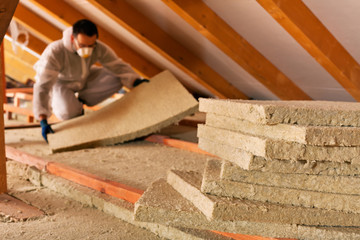Rockwool and Slag wool insulation: Which Is The Sustainable Choice?

For centuries, Rockwool and slag insulations have been made naturally silky threads resemble wool.
This natural inspiration gave rise to one of today’s most versatile and innovative insulation products. Why they are made from abundant basalt and industrial waste.
Rock and Slag Wool Composition and Production Process
Slag wool insulation and Rockwool are made from the same materials but in different amounts. How the manufacturers use the mechanical process to rotate rock composition and slake to high temperature and resistant fibers.
Similar properties result in similar performance characteristics. However the main difference lies in the quantities of each product’s raw materials.
Acoustic insulation slab is primarily made of fibers that are a mixture of blast furnace slag and aluminosilicate (usually basalt) rock.
Rockwool insulation typically contains at least 70 percent to 75 percent natural rocks but Bland furnace slag is the remaining amount of raw material.
Why the main component of slag wool insulation is blast furnace slag. Slag wool insulation typically uses about 70% blast furnace slag. The remainder of the raw materials is natural rock.
Benefits of Rock and Slag Wool
There are many benefits for specifiers, builders, and designers interested in using rock and slag wool insulations with proven performance and environmentally responsible characteristics.
-
Thermal Performance
To ensure their R-values do not decrease over time, rock and slag wool insulations have been tested according to industry standards. Loose-fill and slag insulations are resistant to settling.
-
Fire Resistance
Insulations made of rock and slag wool are non-combustible by nature and will remain that way for the product’s entire life. These insulations are resistant to temperatures exceeding 2,000°F.
This acoustic insulation has a high melting point, which allows them to be used in many applications. These products are compliant with NFPA 220 and the American Society for Testing and Materials E136 standards and testing methods.
Many buildings use rock and slag wool insulations for passive fire protection.
Acoustic ceiling insulation has a fibrous composition that provides flexibility and versatility that is not available in other insulations.
There are many options for rock and slag wool insulations, including batt and loose-fill and spray-applied.
Environmental Benefits
Rock wool and slag-wool insulations have the most significant environmental benefits: they make buildings and equipment more efficient. Thermally efficient buildings and systems require less energy to maintain.
Bland furnace slag is a byproduct of steel manufacturing that makes slag wool. In acoustic floor insulation, slag wool manufacturers used more than 13 billion pounds worth of blast furnace slag between 1992 and 2005.
Which Insulation is the Most Eco-Friendly?
Good insulation will keep your home warm in cold weather and cool in hot summer. Fiberglass insulation was the most popular choice for insulation.
Easy to Install, Moisture, and Fire Resistant
The proper insulation is crucial for insulating your commercial or residential property. It can reduce the time and effort required to install the insulation.
Many professionals choose Rockwool insulation because of its many distinct benefits. Rockwool pipe insulation manufactures and supplies a complete range of “stone wool” insulation products that are smart and durable for construction.
There are products available for roof insulation, attic insulation, and flat roof insulation.
Rockwool’s Advantages
1. Made Of Stone (Basalt Rock) And Recycled Steel Slag.
The Rockwool Flexi slab is a high value slab ideal for multipurpose applications so features a flexible edge that allows it to be put between joists knowing all gaps are well-sealed. This is available in varied sizes.
Fiberglass Insulation Has A Higher R-Value.
Rockwool has a greater R-value for the same thickness. So, if you have a lower target R-value, you may choose a thicker Rockwool batt.
Rockwool 3.5 inches thick = R15, 5.5 inches thick = R23, vs. Fiberglass 3.5 inches thick = R11, 5.5 inches thick = R19.
Moisture Resistant.
This makes your insulation spaces dry and protects the adjacent construction material. It is entirely resistant to mold, mildew and rot and bacterial growth. Rockwool performs well over the long term without compromising your home’s health or integrity.
Fire-Resistant.
Rockwool provides you with peace of mind through a fire-resistant design that places safety first in your living area.
Rodent-Resistant
Rockwool’s steel content will keep rodents away from your insulated space. So who has ever worked with fiberglass knows how itchy and irritating it can be and Rockwool is a solution to this problem.
All-Friction Fit.
This will make installation much easier and quicker.
The Rockwool Flexi is a distinctive insulation product along with a patented flexible corner on single side.
It Is Easy To Use A Serrated Knife To Make Precise Cuts.
You only need a bread-knife knife (Rockwool stocks them) to quickly and accurately cut pieces and create spaces for electrical boxes or other wall features.
Rockwool thermal insulation is denser than fiberglass insulation. Rockwool’s higher airflow resistance means that it can reduce sound transmissions in a quieter environment.
But Installing thermal insulation in your building shouldn’t end with your roof.





